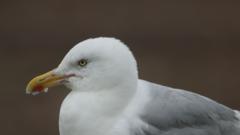Could a Seagull's Fish Theft Lead to Its Fatal End?

Understanding the Herring Gull: A Look into Their Life and Challenges
The recent incident involving a herring gull that tragically lost its life after being kicked for stealing fish from a plate has sparked discussions regarding the treatment and perception of these birds. The Royal Society for the Prevention of Cruelty to Animals (RSPCA) has emphasized the legal protections afforded to gulls under the Wildlife and Countryside Act 1981, indicating that causing harm to these intelligent creatures is not only unethical but illegal. This incident, which occurred on Marine Parade in Barmouth, Gwynedd, highlights the ongoing challenges that herring gulls face, as well as the complex relationship they have with humans.
The Herring Gull: An Overview
The herring gull (Larus argentatus) is a large seabird commonly found along the coasts of Europe and North America. Recognizable by its grey and white plumage, yellow beak, and loud, distinctive calls, this bird plays a critical role in coastal ecosystems. Herring gulls are opportunistic feeders, which means they have a diverse diet that includes fish, crabs, and, increasingly, human leftovers. This adaptability has allowed them to thrive in urban environments where food sources may be more readily available.
The Role of Herring Gulls in the Ecosystem
Herring gulls play a vital role in maintaining the balance of marine ecosystems. They help control fish populations and contribute to nutrient cycling by consuming and dispersing various species. Their scavenging behavior can also aid in cleaning up waste in coastal areas, ensuring a healthier environment. However, as gull populations face pressures from habitat loss, climate change, and human activities, their ability to fulfill these ecological roles is compromised.
Human Interactions and Misunderstandings
Despite their ecological importance, herring gulls often receive negative perceptions from the public. Many people associate these birds with aggressive behavior, particularly when they are scavenging for food. The incident reported in Barmouth is a stark reminder of how misunderstandings can lead to harm. Julia Dalgleish, an RSPCA animal rescue officer, pointed out that gulls are intelligent animals that form strong social bonds, yet many individuals fail to recognize their value.
Legal Protections for Gulls
Under the Wildlife and Countryside Act 1981, herring gulls and their nests are protected, making it illegal to intentionally cause harm. This legislation is crucial in safeguarding their populations, especially as many species are in decline. The RSPCA’s call for witnesses to the recent incident highlights the need for public awareness and accountability regarding the treatment of wildlife.
Challenges Faced by Herring Gulls
Herring gulls are facing multiple challenges that threaten their survival. These include habitat loss, food scarcity, and negative human interactions. Understanding these challenges is essential for developing effective conservation strategies.
Population Decline
Recent studies indicate that gull populations, including herring gulls, are in decline across the UK. The reasons for this decline are multifaceted and include:
- Habitat Loss: Coastal development and changes in land use have significantly reduced available nesting sites.
- Food Scarcity: Overfishing and pollution have diminished the natural food sources that gulls rely on.
- Climate Change: Altered weather patterns and rising sea levels affect breeding sites and food availability.
The Urban Shift
As natural habitats shrink, many gull species, including herring gulls, have turned to urban areas, seeking food sources in human waste. This shift allows them to feed their chicks during the breeding season, but it also leads to increased human-gull interactions. While gulls may benefit from these urban environments, the risks they face from human aggression and vehicle traffic increase significantly.
Breeding and Nesting Challenges
During the breeding season, which typically occurs from late March to July, herring gulls return to their nesting grounds. However, the availability of suitable nesting habitats is declining. Gulls often nest on rooftops or cliffs, which exposes them to human disturbances. Additionally, predation by other animals, such as foxes, poses a significant threat to their chicks.
Understanding Gulls' Behavior and Adaptability
One of the reasons herring gulls are often misunderstood is their behavior. They are known for their intelligence and adaptability, traits that allow them to thrive in various environments. Understanding their behavior can foster a greater appreciation for these birds and help mitigate conflicts with humans.
Intelligence and Social Bonds
Herring gulls exhibit remarkable intelligence, displaying problem-solving abilities and complex social structures. They communicate through a variety of vocalizations and body language, forming strong bonds with their mates and offspring. This social behavior is crucial for their survival, as it helps them coordinate during foraging and protect their young from threats.
Foraging Behavior
Herring gulls are opportunistic feeders, which means they will consume whatever food sources are available. Their diet includes:
- Fish
- Crabs
- Earthworms
- Human food waste
This adaptability is both a survival strategy and a reason for their increasing presence in urban areas. However, it can also lead to conflicts with people when gulls scavenge for food.
Conservation Efforts for Herring Gulls
With herring gull populations declining, various conservation efforts are underway to protect these birds. Engaging the public in understanding and supporting these initiatives is critical for their success.
Public Awareness Campaigns
Organizations like the RSPCA are actively involved in educating the public about the importance of herring gulls. Campaigns focus on:
- Dispelling myths about gull behavior
- Promoting responsible waste disposal to reduce food sources for gulls in urban areas
- Encouraging reporting of illegal activities harming gulls
These initiatives aim to foster a more positive view of gulls and promote coexistence between humans and wildlife.
Habitat Restoration
Restoring natural habitats is vital for supporting herring gull populations. Conservationists are working to:
- Create protected nesting sites
- Implement policies to reduce pollution in coastal areas
- Encourage sustainable fishing practices to ensure food availability
FAQs About Herring Gulls
What do herring gulls eat?
Herring gulls have a varied diet that includes fish, crabs, earthworms, and human food waste. They are opportunistic feeders and will consume whatever food sources are available.
Are herring gulls protected by law?
Yes, herring gulls are protected under the Wildlife and Countryside Act 1981, which makes it illegal to intentionally harm or disturb them.
What can I do to help herring gulls?
You can help herring gulls by practicing responsible waste disposal, supporting conservation initiatives, and educating others about the importance of these birds.
Conclusion
The incident involving the herring gull in Barmouth serves as a poignant reminder of the challenges these birds face in a rapidly changing world. As we continue to encroach on their habitats and alter their food sources, understanding and empathy toward these intelligent creatures become crucial. By fostering a greater appreciation for herring gulls and advocating for their protection, we can work towards a future where humans and wildlife coexist harmoniously. What steps will you take to promote the well-being of our feathered friends? #HerringGulls #WildlifeConservation #BirdWatching
Published: 2025-08-13 12:05:09 | Category: wales



